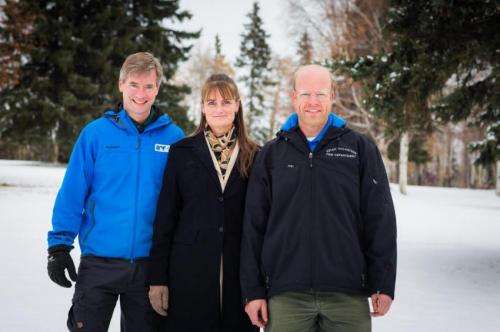University of Alaska Fairbanks reaches new heights with $23.8 million biomedical grant

The University of Alaska Fairbanks received a $23.8 million, five-year award from the National Institutes of Health to launch a new undergraduate program that will engage students from diverse backgrounds, especially those from rural Alaska, in biomedical research as a way to foster their interest and success in biomedical and health careers.
The Biomedical Learning and Student Training program received the competitive award through NIH's Building Infrastructure Leading to Diversity initiative, which awarded funding to 10 programs across the nation. The programs seek to learn how to attract students from diverse backgrounds into the biomedical research workforce and help them become future contributors to NIH-funded research. BUILD is part of the Diversity Consortium—a $240 million commitment to enhancing the diversity of the NIH-funded workforce.
Three UAF researchers lead the project—Barbara Taylor, an associate professor of neurobiology; Karsten Hueffer, an associate professor of veterinary microbiology; and Arleigh Reynolds, associate dean of UAF's Department of Veterinary Medicine.
Taylor, who directs UAF's Office of Undergraduate Research and Scholarly Activity, said BLaST will enhance what the university already does well.
"UAF supports undergraduate research and diversity in science better than most places," she said. "That's what makes us the perfect people to take it to the next level."
BLaST will reach students at UAF and nine rural Alaska campuses through partnerships with the Iḷisaġvik College in Barrow and UA campuses and centers in Southeast Alaska, the Aleutian Islands and western Alaska.
The program will also redefine the classroom experience for all undergraduate students interested human, animal and environmental health by helping faculty of related fields use the research experience as a tool for teaching, allowing students to learn about biomedicine while contributing knowledge to it.
NIH Director Francis Collins said programs like BLaST are using novel approaches that might prove key to attracting students of different backgrounds to the biomedical workforce.
"While past efforts to diversify our workforce have had significant impact on individuals, we have not made substantial progress in supporting diversity," said Collins. "This program will test new models of training and mentoring so that we can ultimately attract the best minds from all groups to biomedical research."
Rural Alaska is diverse on many fronts. A substantial part of the rural Alaska population is Alaska Native, and those who live in the state's remote areas often have close ties to the land and practice subsistence hunting and gathering as part of their lifestyle.
Reynolds said BLaST students' unique blend of cultural and scientific knowledge will become a valuable asset.
"There are some really pressing public health and biomedical questions like climate change that are facing rural Alaska, and they're going to have huge impacts on the way that the culture, economics and lifestyles of people there are going to change," he said. "Students from BLaST will be the best advisers for those communities and can help people make really important decisions about how their life is going to change."
Hueffer said BLaST students can prepare for a variety of careers ranging from lab technician to public health worker to a biomedical researcher. It all depends on what they want to do and the needs of the communities where they live.
"It's important to look at the student and ask where the student wants to be, and how the student can get to that point," he said noting that BLaST is not a one-size-fits all program. "We see it as a pipeline with multiple entry points and multiple exit points."
BLaST will offer student scholarships, professional development workshops, public seminars and funds to improve biomedical facilities at partner institutions. It will complement other NIH-funded programs at UAF like the Center for Alaska Native Health Research and the Institutional Development Award Network of Biomedical Research Excellence, which recently received an $18.8 million renewal in August.
UA Southeast Chancellor John Pugh said the grant sets the bar high in terms of what it sets out to accomplish.
"My initial reaction was to be a bit overwhelmed by the success of this proposal," he said "The Alaska BLaST proposal is very ambitious in its goals and gives us the opportunity to transform science education in Alaska."
All three leads on the BLaST team stressed that it will take many faculty members, graduate students, research institutions and campus partners across Alaska to ensure the project's success.
"There is a great team spirit to build a biomedical research community where everybody from undergraduates to faculty is part of the training, teaching and education," Hueffer said. "We are going to have a BLaST."
Provided by University of Alaska Fairbanks